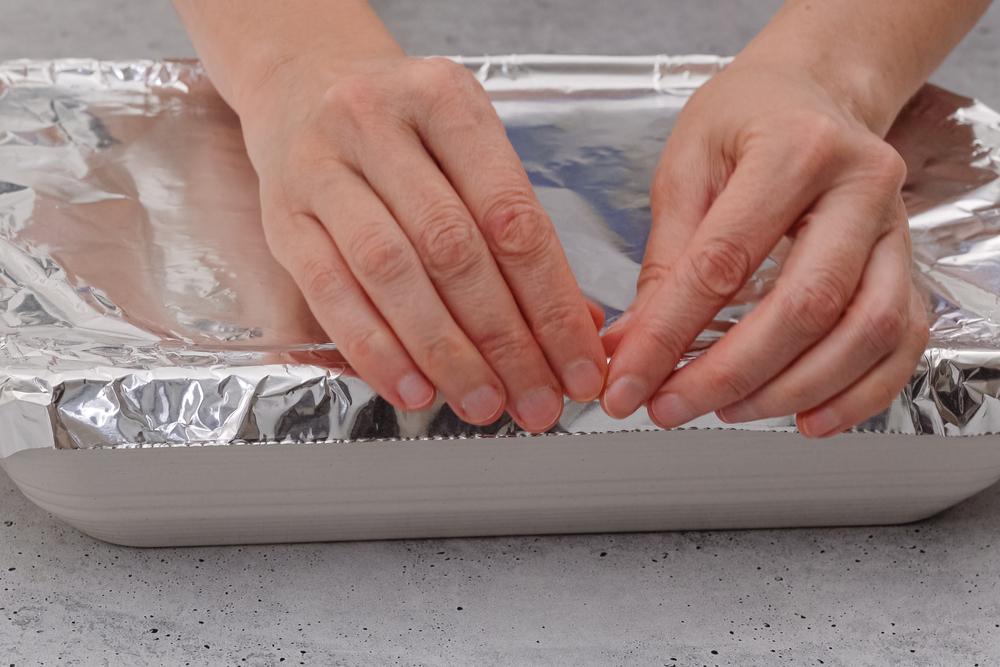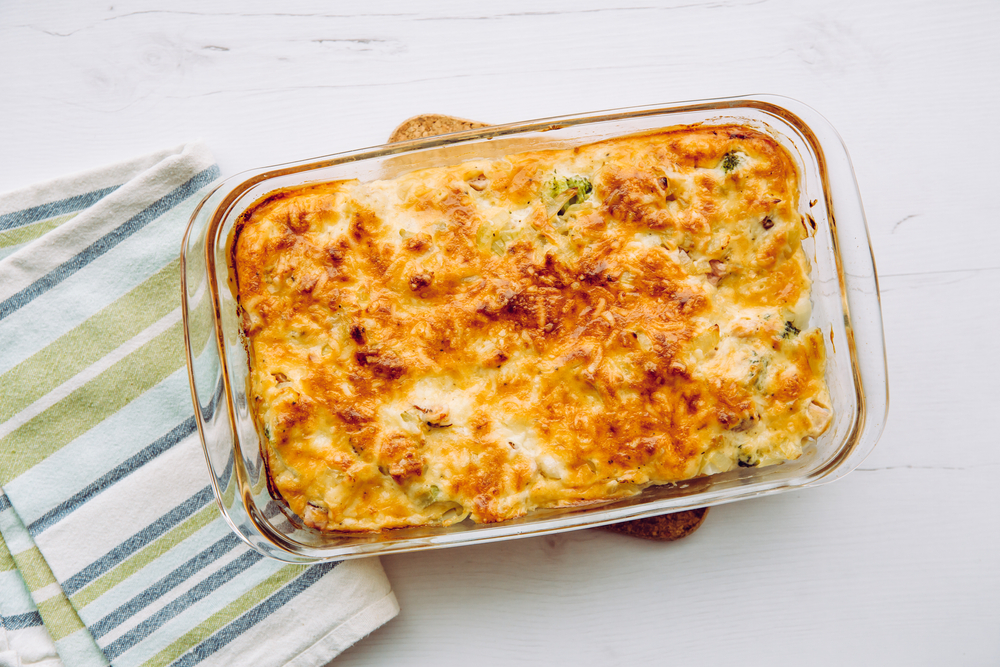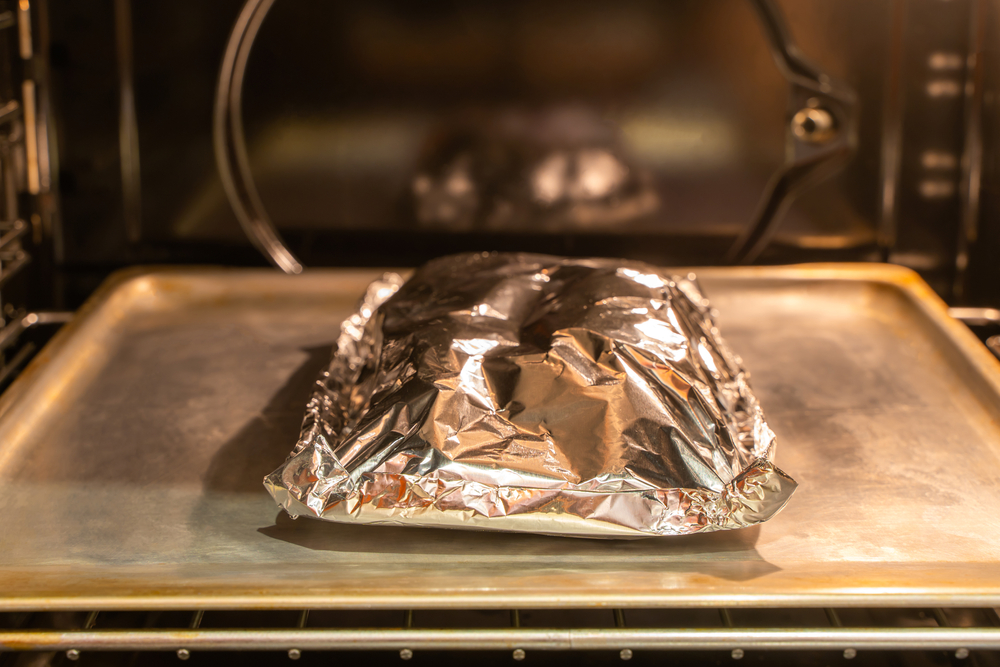The difference is that foods that require baking without a cover will have a dry outer crust or receive a browning texture, while covered foods will retain more moisture and flavors from the ingredients.

Baking a Dish Covered with Foil or a Lid Offers Some Advantages Like Moisture Retention
Individuals who are relatively new to the kitchen or wanting to try experimenting with different methods may not know the significance between covering and uncovering items in the oven. So here is the answer to the common question, baking covered vs uncovered: what’s the difference?
While many people associate baking with baked goods such as sweets and bread products, this process can refer to any meat or food item cooked in the oven using dry heat. For example, casseroles and vegetables often use this method. However, terms like roasting or braising take on a different approach. Here is where the covered vs uncovered debate becomes more apparent.
Always refer to the recipe for proper cooking methods, whether covered or uncovered. This breakdown will help distinguish when each baking approach is suitable.
Baking is the standard method for many pastries and dough-based food items, like bread, cakes, and cookies. These circumstances will use a dry heat method at an average temperature, typically around 350°F. The resulting food will develop a crust or have a browning effect.

Baking a Dish Uncovered can Help Promote Browning and Crispiness
Consequently, the leavening agent within the dough responds to dry heat, causing it to activate and rise. These effects are not as prominent when baked with a cover during baking.
Although some recipes call for covering a cake or pie, this unique method is usually only a temporary phase of its entire baking process. Therefore, the uncovered way is ideal for any typical baked good food items that use dough ingredients.
Other typical meals, like casseroles, can be baked uncovered. Without a cover, these one-dish meals will not contain as much liquid and be easier to serve once done.
If a cover is necessary during the baking process, there will be significant differences in the resulting dish. Often, these situations are not referred to as baking but instead roasting or braising. Many individuals will use a dutch oven or roasting pan in these situations where they need to cover their dish during baking.
Using a cover in the oven is generally standard practice for items that require high temperatures, such as 400°F or more. The cover will help ensure the dish cooks evenly without burning the outside too quickly while the inside is undercooked.

When Cooking at High Temps, Covered is Usually Recommended for at Least the Majority of the Coking Cycle
Covered foods will typically retain more moisture since it remains enclosed within the container rather than escaping into the surrounding oven. Additionally, foil or parchment paper is a terrific alternative to covering a dish in the oven if a lid is unavailable.
Meals with a cover can have more flavor and will not sport an outer crust or dry top because of the excess moisture.
Some recipes can be confusing by stating the first part of the baking process uses a cover while the last phase does not. In these situations, using both methods can help create the perfect dish.
The first cooking phase with a cover will help the food retain moisture and seal in flavor while maintaining a proper internal temperature. In addition, this cover helps prevent the top from browning too quickly or drying out the dish.
Removing the cover during the last phase allows the dish to develop a browning on top or a crust without the risk of overcooking. Uncovering a meal for the final stage can also help ensure that it will not contain excess liquid and allow sauces to thicken up for serving.
Alternatively, a dish that may start in the oven uncovered may cook too quickly or brown too fast. In these situations, using a cover during the last cooking phase can slow down the browning and keep the dish tasty, and therefore it does not dry out while the rest of the food continues to cook.
Unfortunately, there is no simple answer to this question since different foods require unique cooking methods. For example, a roast chicken will cook best covered in a pan, while a chicken breast will cook perfectly fine on a baking sheet while uncovered.
Some factors that help determine which cooking method is best for an oven dish include:
The longer an item remains in the oven, the more it will cook. Some dishes may cook quicker when it remains uncovered in the oven, taking less time overall. However, covering it can extend the cooking time and keep it from drying out or burning too quickly.
One critical fact when determining cooking time for oven dishes is the temperature. These two elements can work together for a tasty meal or cause a dish to be too dry or undercooked, whether it is covered or uncovered while baking.
Naturally, the higher the oven temperature is, the faster a dish will cook. However, uncovered dishes in high temperatures may brown quicker outside than inside, resulting in uneven cooking or the edges or topping burning before the time is complete.
As a basic rule of thumb, uncovered foods usually use a lower oven temperature, while covered foods need higher temperatures.
The desired result for a food item can indicate which method is best. For example, moisture can escape the meat easily when baking a turkey, creating a need for a cover to retain the natural juices. Alternatively, cooking a baked potato with dry skin and a soft center will require the dry heat and be best uncovered.
Foods like cakes or cookies should not use a cover during the baking process since they need to brown from the dry heat of a convection oven. However, a foil cover can be beneficial for a cake that begins baking too quickly as long as it has a top crust before it is covered. This way, the inside of the cake can continue to cook without risking burning the top.
Instant Pots are kitchen appliances that use pressure cooking to create delicious meals in less time. However, they are not the ideal solution for every dish. These appliances cook food inside the canister using high heat and moisture with a closed lid. Therefore, they fall under the classification of baking food covered.
Unlike a traditional oven, Instant Pots cannot cook food uncovered. Dishes in these appliances will not receive a browning effect or develop an outer crust that meals can get in an oven. While Instant Pots are perfect for rice, soups, stews, and even chicken, they are not the best cooking method for some casseroles or pastries.
Covering food in the oven does not always require a roasting pan or lid. Using foil to cover a dish is often beneficial, especially if the food is oversized or in a smaller oven. It can withstand high temperatures and will not melt or leach into food when using it as a cover.
The foil will conduct heat well, making it a perfect solution to cover a pork roast that will keep it in its natural juices. Most of the time, using thin strips of foil around the edges of a pie crust will ensure that these areas do not overcook or burn while the pie bakes in the oven.
One advantage of using foil to cover food rather than a lid is its versatility. Its flexibility allows for full or partial coverage to retain as much or as little moisture as necessary for a particular dish.
Alternatively, parchment paper is perfect for use in an oven with mild to moderate temperatures. For example, if a cake is browning too quickly, using a piece of parchment paper can avoid burning by placing it on top of the pan.
Parchment paper is not as pliable as foil and is not ideal for foods that require high temperatures. This limitation makes it less desirable than using foil for many baking situations.
As a general rule, anytime food bakes in an oven, it should remain uncovered unless the recipe specifically calls for it to have a cover. But there may be instances where a covering is helpful during baking in an oven.
If a dish is cooking too quickly or the top or edges are browning too fast, covering it will slow it down and keep it from burning. Using a cover will keep flavors together, melding within the contents, which can be beneficial for soups or stews with meat and vegetables together.
Some food items will cook faster when covered in an oven since it helps prevents heat loss and does not allow moisture to escape. So using this method can cut down the time necessary to prepare a meal.
